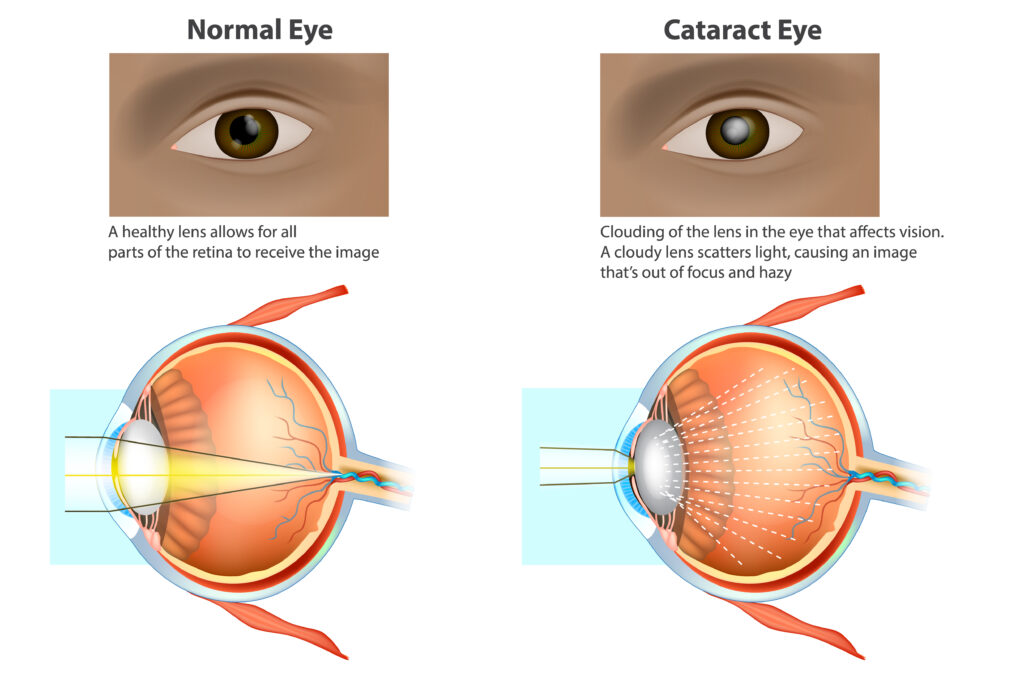A 68-year-old patient presents to the clinic with complaints of gradually worsening vision. Upon examination, the nurse notes that the patient has difficulty seeing at night, increased sensitivity to glare, and a noticeable cloudiness in the lens of the eyes. Which clinical manifestation is most indicative of cataracts?
Cloudiness in the lens of the eyes
Double vision in one eye
Eye pain and redness
Sudden loss of vision
The Correct Answer is A
Choice A Reason:
Cloudiness in the lens of the eyes is the hallmark symptom of cataracts. Cataracts cause the lens to become opaque, leading to blurred vision and difficulty seeing clearly. This cloudiness can make it challenging to perform everyday tasks and is the most indicative sign of cataracts.
Choice B Reason:
Double vision in one eye can occur with cataracts, but it is not the most indicative symptom. While cataracts can cause visual disturbances, the primary symptom is the cloudiness of the lens, which directly impacts vision clarity.
Choice C Reason:
Eye pain and redness are not typical symptoms of cataracts. These symptoms are more commonly associated with other eye conditions such as infections or glaucoma. Cataracts primarily cause visual disturbances without significant pain or redness.
Choice D Reason:
Sudden loss of vision is not characteristic of cataracts. Cataracts develop gradually over time, leading to a slow progression of vision impairment. Sudden vision loss is more likely to be associated with acute conditions such as retinal detachment or vascular occlusions.

Nursing Test Bank
Naxlex Comprehensive Predictor Exams
Related Questions
Correct Answer is D
Explanation
Choice A Reason:
Shortness of breath is not typically associated with Meniere’s disease. This condition primarily affects the inner ear, leading to symptoms related to balance and hearing. Shortness of breath is more commonly linked to respiratory or cardiovascular issues.
Choice B Reason:
Chest pain is not a characteristic symptom of Meniere’s disease. Chest pain is usually related to cardiac or musculoskeletal problems. Meniere’s disease affects the inner ear and does not typically cause chest pain.
Choice C Reason:
Fever is not a common symptom of Meniere’s disease. Fever is generally associated with infections or inflammatory conditions. Meniere’s disease involves the buildup of fluid in the inner ear, leading to vertigo, tinnitus, and hearing loss, but not fever.
Choice D Reason:
Vertigo is the most characteristic symptom of Meniere’s disease. Vertigo involves a spinning sensation that can be severe and debilitating. It is caused by the abnormal fluid buildup in the inner ear, which disrupts the balance and hearing functions. This symptom is a hallmark of Meniere’s disease and is often accompanied by tinnitus and hearing loss.
Correct Answer is A
Explanation
Choice A Reason:
Storing hearing aids in a dry, cool place when not in use is crucial for maintaining their functionality and longevity. Moisture and heat can damage the delicate electronic components of hearing aids. Using a dehumidifier specifically designed for hearing aids can help prevent moisture buildup and extend the life of the devices.
Choice B Reason:
Using cotton swabs to clean the interior components of the hearing aid is not recommended. Cotton swabs can push debris further into the hearing aid and potentially damage the internal components. Instead, specialized cleaning tools such as wax loops, brushes, and earmold tubing blowers should be used to clean hearing aids properly.
Choice C Reason:
It is not okay to wear hearing aids while showering or swimming. Most hearing aids are water-resistant but not waterproof. Exposure to water can damage the hearing aids and affect their performance. It is important to remove hearing aids before any activities involving water.
Choice D Reason:
Replacing the batteries of hearing aids once a month regardless of usage is not necessary. Battery life depends on the type of hearing aid, the battery size, and the amount of usage. It is more practical to replace the batteries when they are low or depleted, as indicated by the hearing aid’s low battery warning.
Whether you are a student looking to ace your exams or a practicing nurse seeking to enhance your expertise , our nursing education contents will empower you with the confidence and competence to make a difference in the lives of patients and become a respected leader in the healthcare field.
Visit Naxlex, invest in your future and unlock endless possibilities with our unparalleled nursing education contents today
Report Wrong Answer on the Current Question
Do you disagree with the answer? If yes, what is your expected answer? Explain.
Kindly be descriptive with the issue you are facing.
